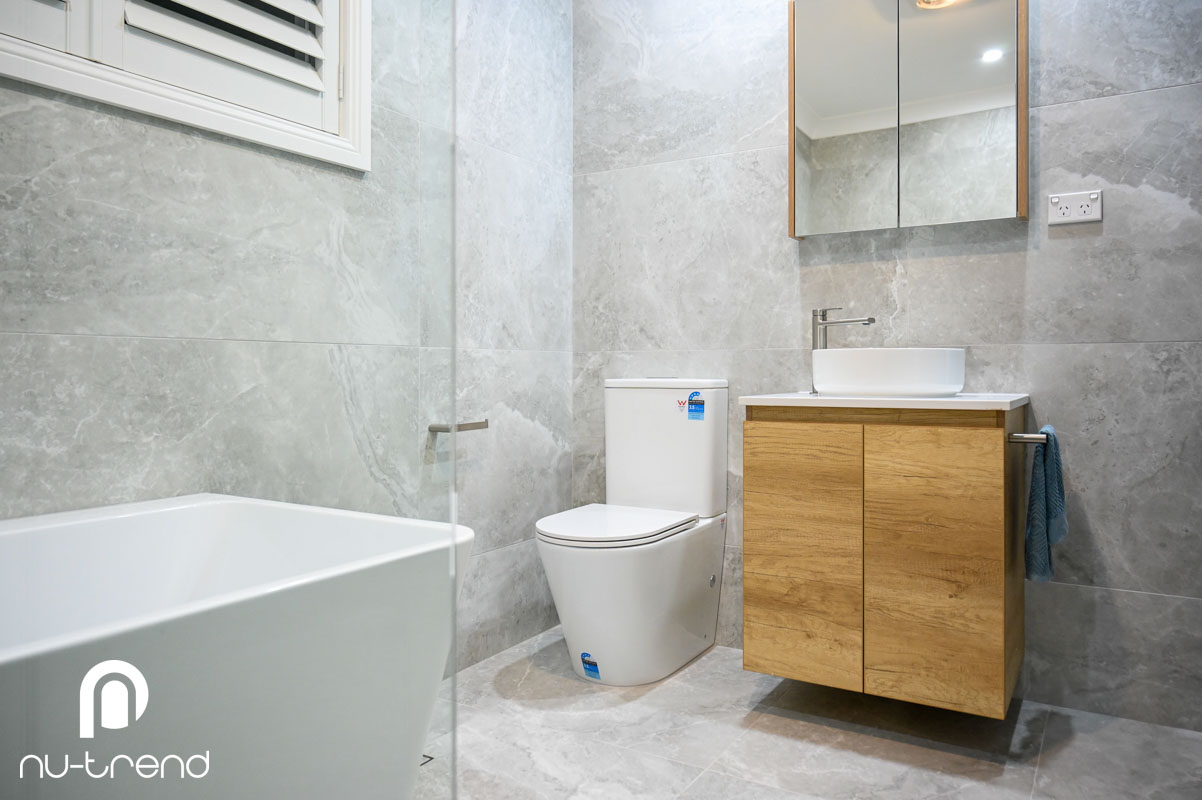You can add another toilet to your home in Sydney

We often get asked about adding another toilet in a home as part of a bathroom renovation in Sydney and there are different ways you can go about it. Adding a toilet to existing plumbing in a home in Sydney, or anywhere else, is a multi-step process. Before you begin, it’s essential that you engage with a licensed plumber who understands local council requirements, the Building Code of Australia and any NSW specific plumbing requirements to ensure any changes being made will comply with legal and safety regulations.
Yes it is possible to watch heaps of YouTube videos and attempt this type of bathroom renovation as a DIY job but the smarter decision will be to use a licensed plumber in Sydney and ideally a company that has bathroom renovation experience as well because these are some of the steps that are needed;
Planning:
- Location: Decide where you want the new toilet. Ideally, it should be close to existing waste lines to simplify installation. A licensed plumber can help you work out where the current plumbing is to then confirm if your preferences are possible or not. It might be a case of needing to install additional plumbing to connect the new location to your existing lines.
- Plumbing Layout: Determine the path for the drain and water supply lines. Keep in mind the slope required for waste pipes to ensure proper drainage. In most cases these will already be in place so the focus will be on
- Venting: Every toilet needs to be vented. Check if you can tie into an existing vent stack or if a new vent will be needed.
- Renovation: whether an area of an existing bathroom or laundry has to be renovated to accomodate the addition of a new toilet will be something that varies from home to home. Obviously if it is a complete bathroom renovation then all of this will be done as part of the overall scope of work. If a toilet is getting added to a laundry then it may mean a small portion of wall and floor tiling needs to be renovated to accomodate the new connections.
Preparation:
- The water mains supply has to be turned off.
- Your plumber will have to make sure they have all the necessary tools and materials, including the toilet suite, flange, wax ring, T-fittings, pipes etc.
- The plumber will then double check the chosen location is suitable, i.e., the floor is level and strong enough to support an additional toilet.
Waste Pipe Installation:
- The plumber will have to cut into the existing waste pipe where you want to connect the new toilet if it is going in a suitable location. Alternatively if a new line has to be run to connect to the existing plumbing then the plumber will have to either cut into the concrete slab to achieve this or run new piping under the floor boards depending on the type of house construction they are working with.
- Once this is done they will install a T-fitting to connect the new waste pipe for the toilet.
- They will ensure the waste pipe slopes correctly to allow for proper drainage to ensure all the waste is moved quickly.
Venting:
- Next step is to connect the new toilet to an existing vent stack or create a new vent. It is important to ensure it extends above the roofline and adheres to any local codes.
If a toilet isn’t properly vented, several issues can arise, impacting the functionality of your plumbing system and potentially leading to more significant problems over time. Here’s what can happen:
Poor Flushing: Without proper venting, toilets may not flush thoroughly or efficiently. This can lead to the bowl not emptying entirely or waste not moving down the drain as it should.
Siphoning of Water from P-Traps: The P-trap is designed to hold water, creating a barrier that prevents sewer gases from entering the home. Improper venting can create a vacuum effect when water drains, which can pull or “siphon” the water out of other P-traps in nearby fixtures. If the water seal in a P-trap gets siphoned out, it can allow sewer gases to enter the home.
Gurgling Noises: When draining, you might hear gurgling or bubbling sounds from the toilet or nearby fixtures. This noise is due to the system trying to pull in air to equalize the pressure.
Slow Drainage: Without proper venting to equalize the pressure, water and waste might drain slower than usual. This can lead to frequent clogs or backups.
Sewer Gas Smell: One of the primary functions of a vent is to channel sewer gases out of the home. If a toilet isn’t vented correctly, these gases might seep into your living space, leading to a foul odor. Continuous exposure to sewer gases can be hazardous to health and may include components like methane, which is flammable.
Negative Pressure: Improper venting can create negative pressure (a vacuum) in the drainage system. This can lead to issues like pulling water out of P-traps and making it harder for water and waste to flow down the drains.
Airlocks: If there’s a blockage in the vent, air can become trapped, causing an airlock. This prevents water from draining until the air is released, making the system less effective.
Water Supply:
- Your plumber will Identify the cold-water supply line so they can install a T-fitting to this line to create a new supply line for the toilet. This has to be connected from the supply line to the toilet’s fill valve using a flexible hose.
Toilet Installation:
- The last steps are to install the closet flange onto the waste pipe, ensuring its top is flush with the finished floor level. Then place a wax ring on the flange to then position the toilet bowl over the flange, aligning the mounting holes.
- Once it is in place then the nuts and bolts can secure the toilet to the floor and once this is done they can connect the tank to the bowl, attach the water supply line to the toilet tank’s fill valve ready to then turn on the water, check for leaks, and test flush the toilet to ensure everything works correctly.
Sealing & Finishing:
- If everything is working the they will apply caulk around the base of the toilet to seal it and provide a neat finish then cleaning up any debris.
As you can see there are a lot of steps, consider hiring a professional plumber or contractor in Sydney because it often means a licensed and insured plumber will deliver quality work and adherence to local regulations.
What are the benefits of adding a toilet to your home in Sydney?
Adding another toilet to your home can offer a range of benefits, both in terms of convenience and potential economic value. Here are some of the advantages:
- Increased Convenience: Having an additional toilet can be especially useful for larger families or households where the bathroom is frequently occupied. It can reduce wait times during morning routines, when guests are over, or during parties and gatherings. A toilet could be added to an existing laundry for example to turn it into a bathroom.
- Enhanced Privacy: If you have guests or if multiple people are staying in your home, an extra toilet can provide more privacy and comfort for everyone involved.
- Increased Property Value: Additional bathrooms or half-baths can enhance the value of your home. Potential homebuyers often consider the number of bathrooms as a significant factor in their purchasing decision.
- Better Guest Experience: If you frequently entertain or have guests, an additional toilet can be a boon. It allows guests to use the facilities without potentially intruding into the private areas of your home.
- Functional Design: Adding another toilet can be an opportunity to design a space that caters to specific needs, such as a powder room for guests, an ensuite for a master bedroom, or a practical bathroom for a basement or entertainment area.
- Potential for Rental: If you’re considering renting out a part of your home, or if you have a granny flat or a similar setup, an additional toilet can make the space more appealing and functional for tenants.
- Emergency Backup: In the event that one toilet is out of order or undergoing repairs, having a backup can be invaluable.
- Flexibility: As families grow and change, having an extra toilet can accommodate evolving needs. For instance, as children grow into teenagers, the demand for bathroom time can significantly increase.
- Efficient Use of Space: If you have unused or underutilized spaces in your home, converting them into a half-bath or full bathroom can be a smart way to maximize the functionality of your living space.
While there are clear benefits to adding another toilet to your home, it’s also essential to consider the costs, the required space, and the potential disruptions during installation. Proper planning and understanding your household’s needs can help you make an informed decision.
Can you add a toilet and a bidet to your home in Sydney?
Yes, you can add both a toilet and a bidet to a home in Sydney and integrate them into the existing plumbing system. When planning to add these fixtures, keep the following considerations in mind:
Drainage and Waste:
Both the toilet and the bidet will require connection to the waste drainage system. If they’re placed close together, it might be possible to connect both fixtures to the same waste line using appropriate fittings. Remember to maintain the correct gradient (slope) for the waste pipes to ensure proper drainage.
Water Supply:
Both fixtures will require cold water connections. Additionally, some bidets (or bidet seats attached to toilets) might require a hot water connection for warm water features. If so, you’ll need to consider proximity to a hot water supply or investigate options like localized water heaters. T-fittings can be used to split the cold water supply to service both the toilet and bidet, but proper water pressure must be maintained for both fixtures to operate effectively.
Venting:
Like all plumbing fixtures, toilets and bidets need to be properly vented to prevent the siphoning of water from P-traps and to ensure efficient drainage. Make sure the venting system can accommodate the additional fixtures.
Space Considerations:
Ensure you have enough space in your bathroom for both a toilet and a bidet. Both should be comfortably accessible, and there should be adequate space for users.
Compliance with Local Codes:
Ensure that all installations comply with the local plumbing codes in Sydney and any regulations specific to New South Wales. This might require permits or inspections. Sydney has particular water efficiency standards due to concerns about water conservation. If buying new fixtures, ensure they meet or exceed the required Water Efficiency Labelling and Standards (WELS) rating.
Professional Installation:
While some enthusiastic DIYers might feel comfortable tackling such a project, it’s often recommended to hire a licensed plumber, especially in Sydney where compliance with local codes is crucial. A professional will ensure the job is done right, reducing the risk of leaks, drainage issues, or non-compliance with regulations. Let’s not forget if you tried doing this yourself you are playing around with the pipes that carry your sewage, so any mistakes can lead to all sorts of problems.
In summary, while it’s entirely feasible to add both a toilet and a bidet to a home in Sydney using the same plumbing system, careful planning, consideration of local codes, and potentially professional assistance are crucial to ensuring a successful installation.




